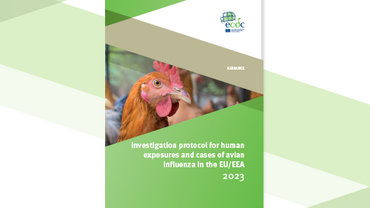Avian flu: increased vigilance recommended
Avian influenza viruses continue to circulate, albeit at low levels, among wild bird populations across the European Union and the European Economic Area (EU/EEA).
In the United States, transmission of highly pathogenic avian influenza HPAI A(H5N1) viruses has recently been observed in dairy cattle and four cases of human avian influenza have been reported among farm workers exposed to cattle since April 2024.
Whilst transmission from infected animals to humans remains a rare event, avian influenza viruses can spill over to wild, farm and domestic animals, leading to infection and outbreaks in poultry, and occasionally in mammals.
“As we closely monitor the current situation on avian influenza, both in the EU and globally, there is reason for increased awareness but not for increased concern. ECDC remains committed in our support of the actions taken by national authorities in EU Member States. This threat to human health should not be underestimated, and it is important that we stay alert and proactive in our joint collaboration.” says Pamela Rendi-Wagner, Director of ECDC.
While currently no infection with the avian influenza A(H5N1) virus in humans has been recorded in the EU/EEA, ECDC advises on the importance of continuing to raise awareness among healthcare professionals, both at primary and secondary care level, regarding the possibility of encountering human cases of infection.
As part of its ongoing commitment to public health, ECDC is implementing a comprehensive strategy to support the early detection and containment of potential human cases in the EU.
It is important to note that currently the risk of zoonotic avian influenza, i.e. human infections, for the EU/EEA remains low for the general population and low-to-moderate for occupationally or otherwise exposed individuals.
ECDC has been taking numerous initiatives to address the potential threat of avian influenza for human health and has produced several guidance documents and reports in recent months on testing of exposed individuals, on surveillance, outbreak investigation and public health options for response.
In recently updated surveillance guidance for the summer period, ECDC recommends lowering the threshold for testing for avian influenza in humans, including using a risk-based approach for exposed asymptomatic individuals. We also recommend testing for influenza all cases hospitalised due to symptoms compatible with avian influenza and to further investigate those influenza A-positive samples that are negative for seasonal influenza virus. Biosafety and personal protective measures in place at occupational and recreational sites with an increased risk of avian influenza remain crucial to minimise the risk of spillover events to humans. These protective measures should be complied with to the greatest extent possible.
Furthermore, ECDC has strengthened its support to EU countries on laboratory activities on zoonotic avian influenza, including support on laboratory preparedness to detect and characterise zoonotic influenza viruses. ECDC also offers EU centralised testing and further characterisation for human specimens known or suspected to contain an avian influenza virus.
In addition to its national partners in the EU and EEA, ECDC continues to closely monitor avian influenza in the EU and globally together with the European Food Safety Authority (EFSA), and in close collaboration with other relevant EU agencies such as the European Medicines Agency (EMA) and the European Agency for Safety and Health Work (EU OSHA) as well as international organisations such as the WHO and major CDCs.
ECDC is committed to maintaining high vigilance to ensure the safety of the public regarding the risk to humans of avian influenza and will continue to provide updates and guidance as needed and according to the epidemiological situation.
Additional resources
Enhanced influenza surveillance to detect avian influenza virus infections in the EU/EEA during the inter-seasonal period
Highly pathogenic avian influenza A(H5N1) viruses continue to be widespread in wild bird populations across the EU/EEA.
Avian influenza overview March–June 2024
Between 16 March and 14 June 2024, 42 highly pathogenic avian influenza (HPAI) A(H5) virus detections were reported in domestic (15) and wild (27) birds across 13 countries in Europe.






